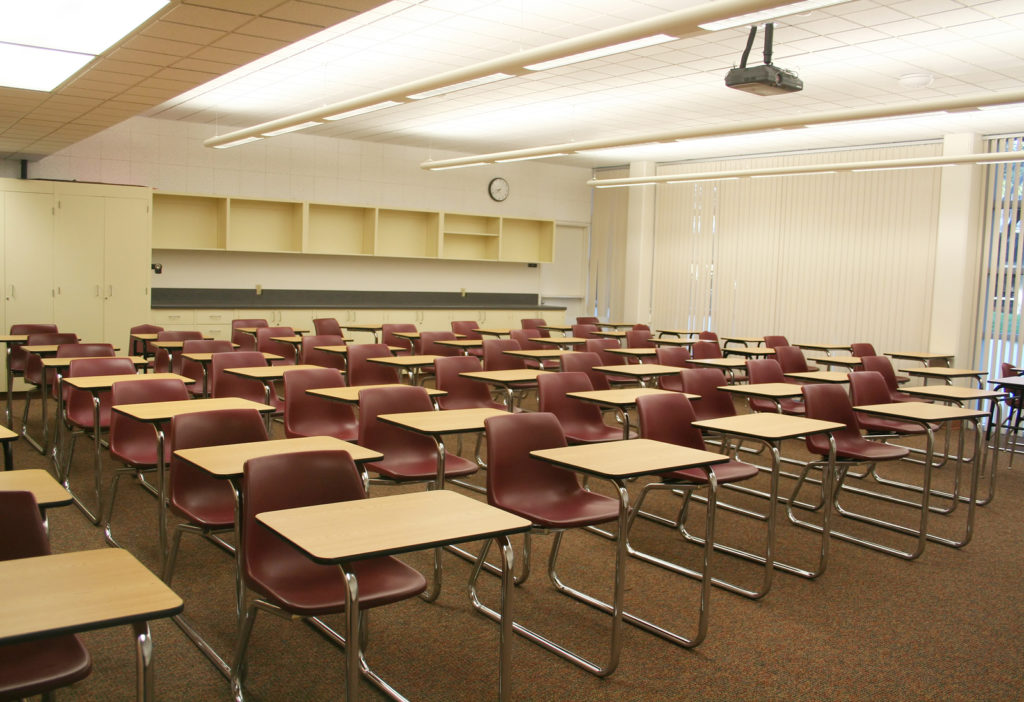10 Reasons Why Experienced and First Year Teachers Have the Same Struggles
11/27/2017

As I reflect on my career as an educator, I am reminded that I am a type of teacher who likes to move around and teach different grade levels. What I realized about myself was that I truly love kids. I love all the different age groups for different reasons. I love their inquisitive nature, little kids' adoration and joy for their teachers and for learning. I love their challenge. I love that they can create such unbelievable pieces of work and they are 10. They are truly remarkable little humans.
My journey took me out of the classroom to become a literacy teacher. I wanted to work with all age levels of kids and help them on an individual basis to work on skills not in place yet. I love reading and books and knew I could make a difference in teaching students to read. I loved my time as a literacy teacher. Near the end of my time I began to feel like a failure as I was not able to continue pulling my groups consistently due to the number of mental health issues in our building that led to big behaviors in our classrooms. This is also where I discovered I loved working with kids who exhibited these big behaviors. These were students who were not identified as special education students. Rather, they were kids who suffered major traumas and did not possess coping strategies to get them through when they were triggered. People would say, "Why do you want to work with such difficult students all day?" and "How do you do that all day?" I really reflected on that and realized that I loved it so much because they were the students that needed me the very most. I could make a difference and see the difference immediately after working with them. The relief these students would experience when we went through de-escalation techniques and I was able to have the time to spend with them to walk them through was so rewarding for me and relieving for them. It is such a powerful feeling becoming someone's safe person. It is life-changing.
Then came the reality of public schools. Budget cuts. Funding only the "necessities", or classroom positions. Last year, I had to say good-bye to the program I worked so hard to build. I truly went through a period of mourning because this was the first change in my career that I did not initiate. It was heart-breaking to think I would no longer be able to work with these students when they needed it in their time of crisis. It was equally heart-breaking to not be able to even see these students on a regular basis when we had spent so much time together over the past couple of years. I felt like I was somehow letting them down and abandoning them. The other part of me, however, was starting to get excited to have my own class again and set up all the lessons, projects, and learnings I had gathered through my past teaching journeys.
As I packed up all my things to move, yet again, into another new classroom, I felt like a brand new, first year teacher as I stood in my perfectly empty, open-space classroom. I had forgotten what that felt like 25 years later but here it hit me like a speeding truck and I was not prepared for it. I want to share with you the ten things I was not ready for or had forgotten about when I was a new teacher.
1 - Stuff, or the Lack of It

As I said before, there I stood in my perfectly empty, open-space classroom. With twenty boxes of kids and teacher books and math manipulatives. That was it. After 25 years, I was starting all over. I had a bookshelf still in the room. I started by scrounging through the basement storage and started googling classroom pictures of other room set ups. I had to look for space saving ideas, plan my area, figure out what I needed when I had no idea what I wanted to do in each space. I could not move forward with any planning, however, until I knew what I wanted to do in each space. When I knew what I wanted to do in each space, I then had to figure out how to fill that space when I had nothing. In an open-space classroom, you design pockets of space as there are no walls or doors to define your space. You need to creatively come up with objects to use for multiple purposes since you do not want to clutter up your space with a bunch of stuff. After spending four years with my kids experiencing behavior triggers, I have learned that more stuff, more clutter, and too much stimulation creates triggers and behaviors are bigger. I took the first month of summer to design my space and then I had to go shopping. I had to outfit my room and I haven't had to fill that much space for 25 years. My bathroom remodel had to go on hold as I scoured garage sales, Good Will, Amazon, and clearance sale racks. My husband proved very supportive and patient as the mailman, Fedex and UPS driver visited our house almost daily through the month of June.
2 - Organizing the Space
Now I had even more boxes and no idea what to do with the stuff. While other teachers were busy meeting and planning for the year, I was still trying to figure out how I wanted my room to look. The difference between my first year of teaching and this time 25 years later was taking into account everything I knew now about clutter, about strategic placement to get the most out of my students and help them keep their triggers at bay. When I was a first year teacher, I planned a room because I liked the way it looked, but now 25 years later, I planned a room based on what my students would need to give them their best chance to learn. This was a huge ah-ha moment for me.
3 - What to Do with All the New Information
This is a hard section for me to name. The month of August, I read every best practices teaching book I could. I read Total Participation Techniques by Himmerle; I read Teach, Reflect, Learn, by Simeral and Hall. I re-read for the fifth time, The Daily 5: Fostering Literacy in the Elementary Grades and The Daily Cafe books by Boushey and Moser. I read these because I knew these were the best practices I wanted to foster in my classroom after years of taking data on students and their learning, triggers, antecedents, etc. in other classrooms. I knew I needed high engagement, active learning, and much reflection on my part to analyze what was working and what I needed to adjust daily. In addition to that, I had several trainings to meet my professional development requirements for my district and I began reading all my curriculum manuals to know what I was required to teach this coming year. Needless to say, my brain was full every night and I had forgotten what it was like to not sleep because of thoughts running over and over in my head. All those millions of questions of how do I incorporate what I am required to teach with what I know to be best practices. I forgot what it felt like to be that overwhelmed.
4 - Organizing My Daily Schedule

Again, everyone was busy planning and I was still trying to organize my day. I spent much of August in my room every day. My summer essentially ended a month early. I had forgotten how much time new teachers donate every day on their own planning and organizing. I had also forgotten how overwhelming it is to try a plan a daily schedule when you have no idea what you are trying to plan for each day. It is difficult to assign amounts of time and certain times of the day to events when you have not even met your students yet, analyzed what their strengths are and when they are at their best. After all my other teaching positions and learnings I gleaned from them, I had another ah-ha as I realized that my time schedule needed to be based on what they needed where I could accommodate that and not on what fit best for me. Teaching is one of those professions where we truly are a guide and should build our templates around the students we get each year. That being said, there are some things that are non-negotiable like recesses, lunch, and specials and then the rest of our learning blocks need to be scheduled based on what my student's strengths are. I was stuck for a while wrestling with this in my mind and it took a long time to put out a schedule. Once I did and started the year, I justified all my stress before school started because what I feared would happen, did happen. I built my first schedule based on what my teaching partner was doing throughout the day. I found once school started that that block of time was always interrupted due to school-wide activities, pull-outs etc. It was in the afternoon and I discovered math scores were my student's lowest scores on our fall MAP screenings and in the afternoon, they were too tired to be open to the new learning. When I switched our times to the morning, I saw an immediate improvement in mastering the new knowledge. I also saw their frustrations, their nervousness and their reaction to math to be a more positive one.
5 - Making Stuff
Not only was my room empty, but I also had nothing made to put up in my room. I had been out of the classroom for 11 years. I, over time, gave away bulletin borders, charts, inspiration hanging signs, etc. to new teachers who were in my same predicament now. They did not have the advantage of a paycheck yet to be able to afford lots of new things to hang in their classrooms and I was not using them so I gave them away. Now I was facing the same issue. Pinterest did not exist when I was in my own classroom all those years ago. I can honestly say, I am grateful it exists now. I spent so many hours browsing and gleaning ideas to build my new room. I spent so many countless hours getting ready, making bulletin boards (on my one wall). Creating book boxes, organizing and labeling reading boxes, math tubs and manipulative boxes, creating binders and the Math with Someone and Math By Myself games that would go in the binders. I was building and making everything which I am still working on doing and adding games today. I had to make everything and I had forgotten how much time, energy, money and supplies it took to make my classroom an interactive learning place.
6 - Building the Curriculum Map
I forgot how the first few months feels like you are driving in the dark with no headlights. You have the general idea where you are trying to go but cannot see where you are going. You trust your partners blindly because they have driven that road before but they are in another car so they are there to make sure you do not drive off the road but they are busy driving their own car. The thing about a 25-year veteran is that everyone expects you to know where you are going and you should be fine getting there but the reality is that this is all so brand new. When I was in the classroom 11 years ago, there was a different curriculum, different books, different expectations, and now there are entirely different technologies as well. On top of the new curriculum, I am learning Chromebooks, on-line summative testing, and preparing for online standardized testing. My sleepless nights are frequent.
7 - Preparation Time
While I am very grateful for my prep times, I did not remember how much time one had to put into planning and preparing. People keep telling me to find a balance and when school was over, I should not be taking a lot of things home. I forgot how much time I spend preparing. If I did not, the only ones to suffer are my students. The responsibility I feel to make this year their best learning year yet, requires that I am the most prepared and efficient that I can be. If I did not think through the learning objectives, plan for triggers, have everything ready so I am not hunting for papers, materials, etc. during the lesson, then my students are the ones who suffer every time. If they suffer, then so do I because that is when I would see behaviors. So, I am at work at 7 am, work every spare minute I have, stay until 5 or 6 each night and come in at least once every weekend. If I do not go into school then I spend a couple of hours at home on schoolwork. At this stage I am building forms, researching ideas, creating spelling lists, tracking progress, updating Mileposts or grades, or learning the math curriculum progression. I am grateful my family is grown and does not need me because I am pretty scarce right now. I had forgotten how much time one needed to devote in order to be prepared and ready daily for students.
8 - Isolation
I forgot how isolating teaching can be. When I was a literacy teacher, I was able to make connections with teachers daily. I could go into classrooms and watch the amazing things they were doing every day. I got to collaborate daily with every grade level and I got to see kids in their environment. I got to ask questions, pick my colleagues brains, and get feedback when I had questions. This all happened because I had the time to go into the rooms and make connections with teachers and students. It was one of the most rewarding parts of my job. Now that I am back in the classroom I rarely see another adult unless they just happen to stop by in my room. I rarely leave my room and when I am done with duty after school, everyone is as tired as I am and they leave before I am able to even get my room cleaned up and ready for the next day. I miss my teacher friends and being able to see all grade levels of kids and adults. I realize how difficult this must be for our brand-new teachers trying to make connections because when one goes that long without adult interaction, it makes it difficult to create and feel joy. We must stop and take time to cultivate those relationships with each other so that level of support is there for everyone.

9 - Balance
Teaching will fill up every space you have if you will let it. When I was a behavior specialist, I took my student's stories home and it greatly affected me emotionally because I couldn't always fix it. That was the only part I took home, however. In the classroom, not only do I take home their stories, but I also take home papers to be graded, my curriculum decisions and planning, the project planning, the Chromebook planning and implementation, lesson planning, etc. I have had to create a timeline for myself so that school only gets an hour to an hour and a half each night and once I hit that, I am done for the night. If not, I could "do school" nonstop each and every day and night.
10 - Time
The best part of my behavior job was that I could take the time to help students work through their issues. I could help them with their friendship issues, their playground "fights", the girl drama, the trauma from their homes the night before. What I needed to be successful in that part of my job was the time to devote to each situation. Sometimes I needed 10 minutes and they had a good plan to implement but other times, I needed a couple of hours to work them around, get a good plan and get them back to class. The most frustrating part of my new, classroom job is not having that time anymore. I cannot take that kind of time to work problems around because quite frankly, there is not that kind of time to take from anywhere without impacting 25 other students. Kids who worked with me last year that are in my class or the other class this year are also struggling with that new set of parameters that being a classroom teacher brings. I struggle with finding the balance of academics and social adjustments because academics without social adjustment strategies and regulation techniques simply does not ever happen. Kids who are unregulated require your time to remind them of strategies, to provide support to regulate and get back to academics. I had forgotten how limiting the structure of the classroom can be when little humans need us the most.
They say teaching gets easier every year but what I really think that statement means is each year, the preparation to teach is what gets easier every year. One does not have to find even more time getting ready to do the teaching. Each year, you add more and more books, materials, manipulatives, binder games and activities and therefore, you do not need to find time to build entire classroom sets of absolutely everything. Your lights that were turned off all year as you tried to find your way through the curriculum are a bit brighter now as you at least have the start of an idea of what is coming. However, the art of teaching is no easier the first year or the 25th year. Veteran teachers may have a few more experiences to draw from but the self-reflection, the lesson design based on this year's student's needs, meeting the needs of 25 different levels of abilities in kids, the numbers of students, and the time spent making the classroom an interactive learning place is still the same grueling challenge. Your students each year have one shot at your grade level and it needs to be the very best year you can possibly provide for them. That, to me, means, you do not have time to take a day, or even an hour, off, you must give them your very best each and every day if they are to make one year's growth in one year's time. So, to my first-year teacher friends, my returning teachers taking on new assignments by choice or not, and my veteran colleagues, I applaud and honor you. I can appreciate your struggles, I support you, and I encourage you to stick to the most challenging and the most rewarding job you will ever do.
- A 5th Grade Teacher’s Guide to Surviving October - October 10, 2018
- Dear Students… Here are the 5 Big Ideas I Hope You Learned This Year - May 21, 2018
- 11 Strategies to Encourage Students to Own Their Learning - January 19, 2018










